Paris 2010: Is it the end of the car, as we know it?
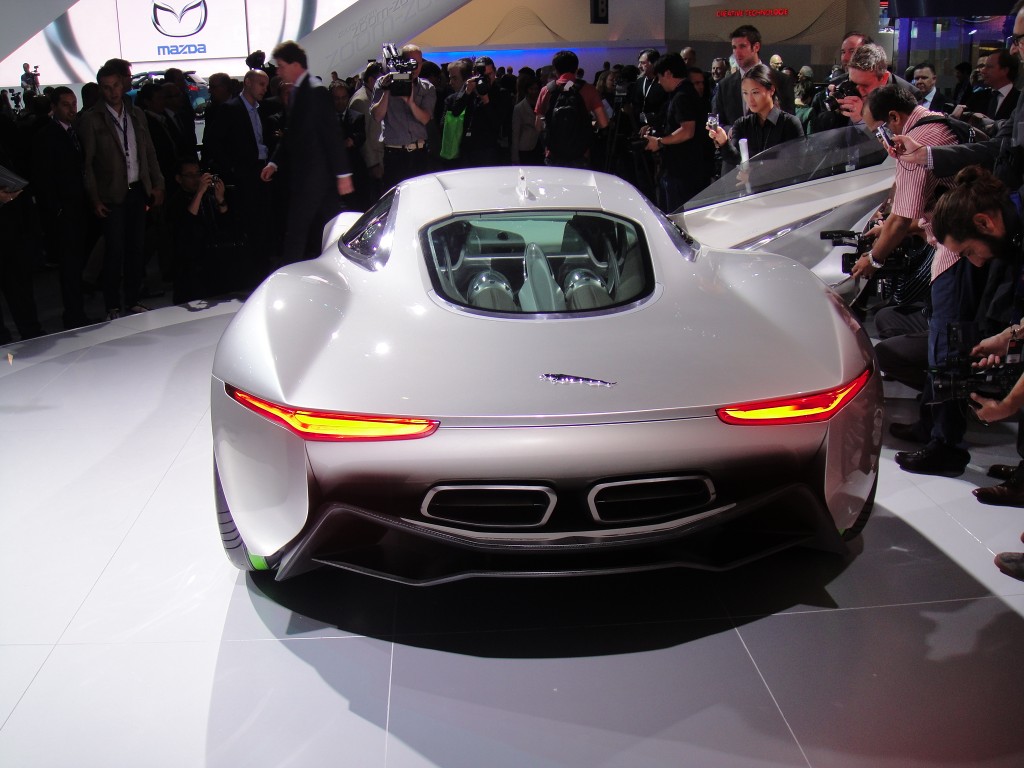 Story and photos by John LeBlanc
PARIS — Woe be the modern automaker. With a lingering economic recession, ever-tightening fuel economy and emissions regulations and a younger population that is more interested in their next cell phone than their next set of four wheels, the global auto industry is seemingly under attack from all sides.
But on the eve of this year’s Paris auto show, as if donning a cape and painting a big red “S” on his chest, Dieter Zetsche — who holds the dual titles of chairman of the board of parent Daimler and head of Mercedes-Benz cars — took up the torch to defend the modern automobile. Zetsche — wrapped in what was ostensibly a speech to kick off the countdown to Mercedes-Benz’s celebration of the forthcoming 125th anniversary of company co-founder Carl Benz’s filing of the first patent for a gas-fueled automobile on Jan. 29, 1886 — said that, as a tool for freedom and innovation, nothing can be compared to the automobile.
Imagine what the world would be like without the car? Before the invention of the automobile, he said, the average citizen only traveled 20 kilometres a year. And today, 12 million European jobs are dependent on the automobile industry which contributes up to $370 B Euros annually to the European economy.
But then the man known as “Dr. Z” invited us to visit the Mercedes-Benz Smart brand’s show booth the next day, where it would debut two alternatives to the type of vehicle Carl Benz created 125 years ago: an electric scooter and an electric bicycle.
The parallels between this year’s Paris show, and the first one — in fact, the very first “automobile” show anywhere — held in 1889, are eerie. Back then, inventors like Benz were looking for an alternative to those foul-smelling things that were overcrowding major cities around the world: horses. Today, many see cars in the same negative vein. But with a phalanx of creative solutions popping up on Paris show stands (Turbine hybrids! Carbon-fibre super sports cars!), this year’s show may go down in history as the unofficial end of the internal combustion-engine car as we’ve known it for more than a century and a quarter — or not.
Story and photos by John LeBlanc
PARIS — Woe be the modern automaker. With a lingering economic recession, ever-tightening fuel economy and emissions regulations and a younger population that is more interested in their next cell phone than their next set of four wheels, the global auto industry is seemingly under attack from all sides.
But on the eve of this year’s Paris auto show, as if donning a cape and painting a big red “S” on his chest, Dieter Zetsche — who holds the dual titles of chairman of the board of parent Daimler and head of Mercedes-Benz cars — took up the torch to defend the modern automobile. Zetsche — wrapped in what was ostensibly a speech to kick off the countdown to Mercedes-Benz’s celebration of the forthcoming 125th anniversary of company co-founder Carl Benz’s filing of the first patent for a gas-fueled automobile on Jan. 29, 1886 — said that, as a tool for freedom and innovation, nothing can be compared to the automobile.
Imagine what the world would be like without the car? Before the invention of the automobile, he said, the average citizen only traveled 20 kilometres a year. And today, 12 million European jobs are dependent on the automobile industry which contributes up to $370 B Euros annually to the European economy.
But then the man known as “Dr. Z” invited us to visit the Mercedes-Benz Smart brand’s show booth the next day, where it would debut two alternatives to the type of vehicle Carl Benz created 125 years ago: an electric scooter and an electric bicycle.
The parallels between this year’s Paris show, and the first one — in fact, the very first “automobile” show anywhere — held in 1889, are eerie. Back then, inventors like Benz were looking for an alternative to those foul-smelling things that were overcrowding major cities around the world: horses. Today, many see cars in the same negative vein. But with a phalanx of creative solutions popping up on Paris show stands (Turbine hybrids! Carbon-fibre super sports cars!), this year’s show may go down in history as the unofficial end of the internal combustion-engine car as we’ve known it for more than a century and a quarter — or not.
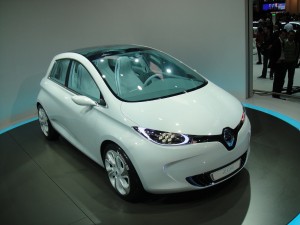 Most of the buzz we all heard in Paris this year was the hum of electric vehicles — both of the two- and four-wheel kind. Many were quirky (Kia’s Pop.) Some were mere flights of fancy (Citröen Lacoste). But then, zut alors, there was the home team from Renault. Its Napoleonic CEO, Carlos Ghosn, led the charge of its electric brigade with four production-ready (like the Zoe, left, on sale starting next year in France) and realistically-priced (about the same as diesels, when government rebates are taken into account) electric vehicles. Also noteworthy: The Canadian-bound Leaf and a future Infiniti are coming our way from the French automaker’s Japanese partner, Nissan.
While mass market makers like Renault/Nissan have the economies of scale and massive resources to bring EVs to the common man, some of the low-volume automakers, those who have the farthest to travel to meet government regs and the most to lose if they don’t, displayed signs of genuine ingenuity that may, in the end, supercede EVs as real alternatives to what we are used to driving today.
Most of the buzz we all heard in Paris this year was the hum of electric vehicles — both of the two- and four-wheel kind. Many were quirky (Kia’s Pop.) Some were mere flights of fancy (Citröen Lacoste). But then, zut alors, there was the home team from Renault. Its Napoleonic CEO, Carlos Ghosn, led the charge of its electric brigade with four production-ready (like the Zoe, left, on sale starting next year in France) and realistically-priced (about the same as diesels, when government rebates are taken into account) electric vehicles. Also noteworthy: The Canadian-bound Leaf and a future Infiniti are coming our way from the French automaker’s Japanese partner, Nissan.
While mass market makers like Renault/Nissan have the economies of scale and massive resources to bring EVs to the common man, some of the low-volume automakers, those who have the farthest to travel to meet government regs and the most to lose if they don’t, displayed signs of genuine ingenuity that may, in the end, supercede EVs as real alternatives to what we are used to driving today.
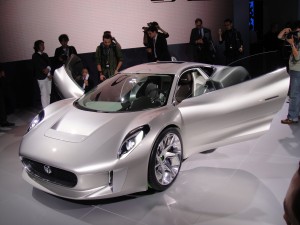 Arguably the stunner of this year’s Paris show was Jaguar’s C-X75 (left and at the top of the page) — and not just for its outrageous styling. Like the revolutionary Chevrolet Volt, the Jag is an extended-range electric hybrid. But instead of a small internal-combustion engine, the C-X75 uses a pair of tiny (about the size of a 1-litre Coke bottle) turbine engines. They charge the batteries that deliver power to the C-X75’s four in-wheel electric motors and can burn anything from diesel to plant-based ethanol. To add some credibility to a seemingly incredible concept, Jaguar’s owner, India’s Tata, even announced that it had purchased a share in the British-based micro gas turbine engine company, Bladon Jets, that make the micro-turbines.
Besides EVs, weight reduction in cars was also a trend worth noting in Paris, led by none other than Italy’s horsepower junkies, Lamborghini.
Arguably the stunner of this year’s Paris show was Jaguar’s C-X75 (left and at the top of the page) — and not just for its outrageous styling. Like the revolutionary Chevrolet Volt, the Jag is an extended-range electric hybrid. But instead of a small internal-combustion engine, the C-X75 uses a pair of tiny (about the size of a 1-litre Coke bottle) turbine engines. They charge the batteries that deliver power to the C-X75’s four in-wheel electric motors and can burn anything from diesel to plant-based ethanol. To add some credibility to a seemingly incredible concept, Jaguar’s owner, India’s Tata, even announced that it had purchased a share in the British-based micro gas turbine engine company, Bladon Jets, that make the micro-turbines.
Besides EVs, weight reduction in cars was also a trend worth noting in Paris, led by none other than Italy’s horsepower junkies, Lamborghini.
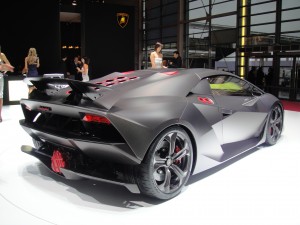 While many speculated that the super sports carmaker was going to show up with a 12-cylinder replacement for its range-topping Murcielago — a direct descendent of the original 1970s Countach —Lamborghini went all Jenny Craig on us instead and arrived with its Sesto Elemento concept, a trimmed down version of its Baby Lambo, the V10 Gallardo, built using lightweight carbon-fibre. Working with the U.S. airplane maker Boeing, the Sesto Elemento (above) uses a new type of forged carbon, said to be cheaper and easier to make than current carbon-fiber. The result is a claimed curb weight of a Smart ForTwo (999 kg), less than two-thirds the heft of today’s Gallardo.
In the near future, at least, no matter how utopian the EVs’ promise of “zero emissions” sounds, or how cool it would be to fire up a turbine-powered car for a Sunday morning drive, the world can’t change overnight. The majority of car buyers around the world will be still driving some kind of fossil fueled, internal combustion-powered car for the foreseeable future. But one change that can have an immediate impact is to get buyers into smaller cars, even buyers in need of some utility. And this year’s Paris show saw a big move into small, practical cars.
While many speculated that the super sports carmaker was going to show up with a 12-cylinder replacement for its range-topping Murcielago — a direct descendent of the original 1970s Countach —Lamborghini went all Jenny Craig on us instead and arrived with its Sesto Elemento concept, a trimmed down version of its Baby Lambo, the V10 Gallardo, built using lightweight carbon-fibre. Working with the U.S. airplane maker Boeing, the Sesto Elemento (above) uses a new type of forged carbon, said to be cheaper and easier to make than current carbon-fiber. The result is a claimed curb weight of a Smart ForTwo (999 kg), less than two-thirds the heft of today’s Gallardo.
In the near future, at least, no matter how utopian the EVs’ promise of “zero emissions” sounds, or how cool it would be to fire up a turbine-powered car for a Sunday morning drive, the world can’t change overnight. The majority of car buyers around the world will be still driving some kind of fossil fueled, internal combustion-powered car for the foreseeable future. But one change that can have an immediate impact is to get buyers into smaller cars, even buyers in need of some utility. And this year’s Paris show saw a big move into small, practical cars.
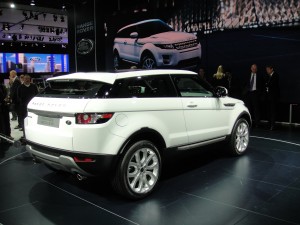 The new Cruze-based 2012 Chevrolet Orlando compact-MPV debuted here, a car that will come to Canada and not the U.S. The rival Ford C-Max and Grand C-Max also debuted here, adding some competition to the popular Mazda5 mini-minivan. Even luxurious SUVs are getting smaller. Land River’s Range Rover brand showed off its Evoque (above), a compact SUV that will come in three- and five-door configurations.
Despite this year’s inspiring ideas from Paris, Zetsche is bang on: the auto industry has its feet to the fire. But some of the solutions from this year’s show may end up being as significant as Carl Benz’s creation 125 years ago.
Sorry to say, EV fans: Despite the hype, EVs aren’t the sole solution. The lack of a recharging infrastructure, limitations on battery capacity and the lack of vehicle variety means this first wave of EVs are still not where they need to be for most car buyers’ transportation needs.
But a compendium of this year’s Parisian concepts — like a car that could take the kids to hockey practice, weigh as much as a Smart ForTwo and be powered by a zero-emissions turbine-electric range extender — may make the cars of today look like the horses of the 19th century.
The new Cruze-based 2012 Chevrolet Orlando compact-MPV debuted here, a car that will come to Canada and not the U.S. The rival Ford C-Max and Grand C-Max also debuted here, adding some competition to the popular Mazda5 mini-minivan. Even luxurious SUVs are getting smaller. Land River’s Range Rover brand showed off its Evoque (above), a compact SUV that will come in three- and five-door configurations.
Despite this year’s inspiring ideas from Paris, Zetsche is bang on: the auto industry has its feet to the fire. But some of the solutions from this year’s show may end up being as significant as Carl Benz’s creation 125 years ago.
Sorry to say, EV fans: Despite the hype, EVs aren’t the sole solution. The lack of a recharging infrastructure, limitations on battery capacity and the lack of vehicle variety means this first wave of EVs are still not where they need to be for most car buyers’ transportation needs.
But a compendium of this year’s Parisian concepts — like a car that could take the kids to hockey practice, weigh as much as a Smart ForTwo and be powered by a zero-emissions turbine-electric range extender — may make the cars of today look like the horses of the 19th century.
10.09.10 | 2010, Chevrolet, Ford, Infiniti, Jaguar, Lamborghini, Land Rover, Mercedes-Benz, Nissan, Paris, Renault, Smart | 2 Comments
Comments
2 Responses to “Paris 2010: Is it the end of the car, as we know it?”





October 11th, 2010 @ 3:08 pm
[…] all the groundbreaking cars at this year’s Parisian shindig, personally, Audi’s Quattro Concept was my out-and-out fave. […]
November 4th, 2010 @ 10:48 am
[…] affordable, zero-emission car,” the first of a host of production EVs the Japanese automaker (and its French partner Renault) plans on introducing over the next few […]